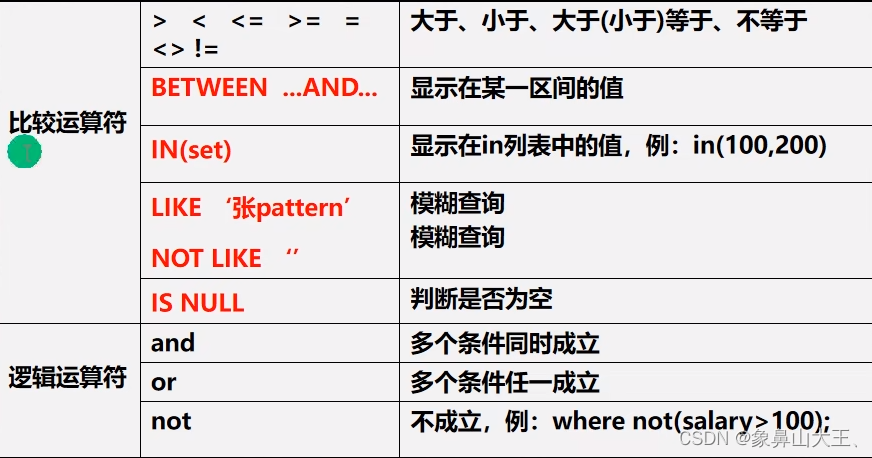一、INSERT 添加
公式 INSERT INTO table_name [(column [, column...])] VALUES (value [, value...]);
示例:
CREATE TABLE `goods` (id INT ,good_name VARCHAR(10),price DOUBLE );
#添加数据
INSERT INTO goods (id,good_name,price ) VALUES (20,'华为手机', 2000); ·细节说明
1.插入的数据应与字段的数据类型相同。比如把‘abc'添加到int类型会错误
2.数据的长度应在列的规定范围内,例如:不能将一个长度为80的字符串加入到长度为40的列中。
3.在values中列出的数据位置必须与被加入的列的排列位置相对应。
4.字符和日期型数据应包含在单引号中。
5.列可以插入空值[前提是该字段允许为空],insert into table value(null)
6.insert into tab_name (列名..) values(),(),() 形式添加多条记录
INSERT INTO goods (id,good_name,price)VALUES (31,'三星手机',2000),(40,'小米手机',2000),(50,'vivo手机',2000);
7.如果是给表中的所有字段添加数据,可以不写前面的字段名称
INSERT INTO goods VALUES (30,'华为手机', 2000);
8.默认值的使用,当不给某个字段值时,如果有默认值就会添加,否则报错
二、UPDATE 更新
UPDATE tbl name
SET col_namel=exprl [, col_name2=expr2 ..]
[WHERE where definition]
特别注意,一定要写where条件, 更新一时爽,交付火葬场! (强烈建议备份好数据)
#给101员工的工资增加1000
UPDATE employee SET salary = salary+1000 where id = 101;三、DELETE 删除
特别注意,一定要写where条件, 更新一时爽,交付火葬场! (强烈建议备份好数据)
公式 delete from tbl_name
[WHERE where definition]
delete from tbl_name[WHERE where definition]1.如果不使用where子句,将删除表中所有数据。
2.Delete语句不能删除某一列的值(可使用update设为null或者")
3.使用delete语句仅删除记录,不删除表本身。如要删除表,使用droptable语句。drop table表名;
四、SELECT 添加
1、公式:
SELECT [DISTINCT] *|{columnl,column2.column3..} FROM tablename;
解释:DISTINCT 表示筛掉重复数据,
示例:
CREATE TABLE student (id INT NOT NULL DEFAULT 1,`name` varchar(20) not null default '',chinese float not null default 0.0,english float not null default 0.0,math float not null default 0.0 );insert into student values (1,'曹操',77,89,85);insert into student values (2,'刘备',80,89,90);insert into student values (3,'孙权',87,79,86);insert into student values (4,'诸葛亮',88,89,90);insert into student values (5,'郭嘉',82,89,85);insert into student values (6,'周瑜',79,89,99);insert into student values (7,'荀彧',79,90,80);
#查询所有学生成绩
select * from student;
#查询所有学生姓名及对应的英语成绩
select `name`, english from student;
#查询所有英语成绩并除去重复的值
select distinct english from student;2、使用表达式对查询的列进行运算
SELECT *|{columnl |expression, column2 |expression,..}
FROM tablename;
3、别名
select colunm_name as 别名 from table_name;
#统计所有学生的总分
select name, (chinese+english+math) from student;
#给所有学生的总分加十分
select name, (chinese+english+math+10) from student;
#使用别名表示学生分数
select name, (chinese+english+math+10) AS TOTAL_SCORE from student;4、where子句中,经常使用的运算符

#查询姓名为荀彧的学生成绩
select name, (chinese+english+math) from student where name = '荀彧';
#查询英语成绩大于等于90分的同学
select name, (chinese+english+math) from student where english >=90;
#查询总分大于200分的所有同学
select name, (chinese+english+math) from student where (chinese+english+math) >200;
#查询math大于60分且id>90的学生成绩
select name, (chinese+english+math) from student where math >60 and id <3;
#查询总分大于200分且数学成绩小于语文成绩的孙姓同学
select name, (chinese+english+math) from student where (chinese+english+math) >200 and math < chinese and `name` like '孙%';#1、查询英语分数在80 - 90 之间的同学
select * from student where english between 80 and 90
#2查询数学分数为89,90,91的同学
select * from student where math in (89,90,91);
#3查询所有姓李的学生成绩
select * from student where `name` like '李%';
#4查询数学分>80,语文分>80的同学
select * from student where math>80 and chinese >80;#1查询语文分数在70 - 80之间的同学
select * from student where chinese between 70 and 80;
#2查询总分为189,190,191的同学
select * from student where (chinese+english+math) in (189,190,191);
#3查询所有姓孙 或者 姓曹 的学生成绩
select * from student where `name` like '孙%' or `name` like '曹%';
#4查询数学比语文多30分的同学
select * from student where (math-chinese)>30;5、使用order by子句排序查询结果。
公式: SELECT columnl,column2. column3..
FROM table
order by column asc|desc, ...;
1.Order by指定排序的列,排序的列既可以是表中的列名,也可以是select语句后指定的列名。
2.Asc升序[默认]、Desc降序
3.ORDER BY子句应位于SELECT语句的结尾。
#对数学成绩排序后输出【升序】
select math from student order by math;
#对总分按从高到底的顺序输出
select (chinese+english+math) as total_score from student order by total_score;
#对姓刘的学生成绩(总分)排序输出(升序)
select (chinese+english+math) as total_score from student where `name` like '刘%' order by total_score;


)

)





通过OF函数获取设备树中断信息实验)




与验证码安全 (pikachu靶场) 全网最详解包含代码审计)

